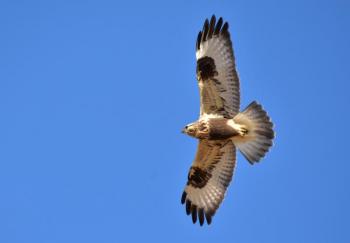There is a large area of farm fields not too far from where we live that is a favorite spot for us to check for birds just about any time of the year. Last week we counted 18 bald eagles there. Most were sitting on the frozen snow around what we assumed was the remains of a cow carcass. The biggest, toughest eagle sat on the carcass and, when another approached, raised its wings half-open and glowered at the intruder until it backed off. If the challenger didn’t retreat, it was treated to a jab from the boss eagle and to some loud, high-pitched calls.
Eagles may not be the first bird that comes to mind when you think of bird species that might hang around farms in winter. Many farms have their own resident flocks of house sparrows and European starlings. Both seem to find enough spilled grain and seed-filled manure right around the barns and out-buildings to make it through a Maine winter. Several times over the winter we’ve spotted a few brown-headed cowbirds hanging out in the flock of starlings. They also eat seeds picked from chaff and manure.
We’ve been seeing dozens of wild turkeys in the farm fields there, too. They stay a little farther out behind the cow barn, scratching around in the field. Some years we’ve seen 50 or more at a time. As spring warmth returns, we’ll see the males spreading their tails to show how wonderful they are to the surrounding ladies.
There are almost always a few red-tailed hawks sitting around the field edges in winter, patiently waiting and watching for the slightest movement of a rodent. Last week we were excited to see there a rough-legged hawk, a winter visitor from northern Canada.
The farm has recently been moving manure from the barn into some back fields. As many a birder may know, that’s a recipe for attracting other ground-loving winter birds. The late Inez Boyd, a wonderful birder from Bangor, used to always comment whenever she noticed manure on a farm field in winter. Being of an older, proper generation, though, she never used the term “manure.” Instead, she would always refer to it “dressing,” as in, “There’s fresh dressing on the field, perhaps we should scan through it for birds.” It left a strong enough impression that now we always look for birds when manure (or dressing, if you prefer) has been newly spread on fields.
We pulled out the telescope when we saw the manure being hauled from the barn at our favorite farm field and began to scan. Sure enough, there was a small flock of horned larks scampering about the edges of the track where the tractor was hauling the loads back and forth. Another bird that feeds in open fields on spread manure is the snow bunting, but we haven’t found any there quite yet. February and March are the times when both horned larks and snow buntings migrate back north after spending the winter here in Maine or points south. We’ll be watching to see if more of either come to feed in our favorite farm fields, especially if we spy some fresh dressing.
Jeffrey V. Wells, Ph.D., is a Fellow of the Cornell Lab of Ornithology and Vice President of Boreal Conservation for National Audubon. Dr. Wells is one of the nation's leading bird experts and conservation biologists and author of the “Birder’s Conservation Handbook.” His grandfather, the late John Chase, was a columnist for the Boothbay Register for many years. Allison Childs Wells, formerly of the Cornell Lab of Ornithology, is a senior director at the Natural Resources Council of Maine, a nonprofit membership organization working statewide to protect the nature of Maine. Both are widely published natural history writers and are the authors of the popular books, “Maine’s Favorite Birds” (Tilbury House) and “Birds of Aruba, Bonaire, and Curaçao: A Site and Field Guide,” (Cornell University Press).


.jpg)



























